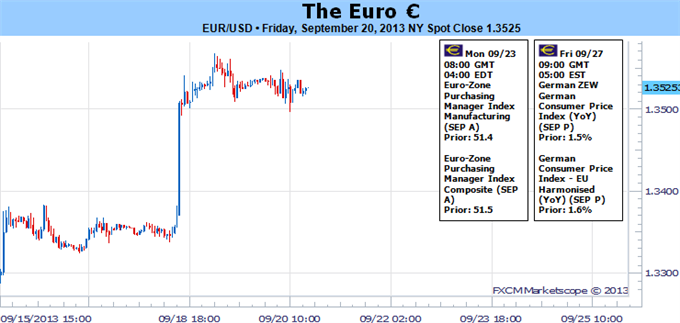
Euro/US Dollar Look to Risk, PMIs and German Election to Hold 1.3500
Fundamental Forecast for Euro: Neutral
The German elections will draw the top headlines in Europe, but its negative impact will likely be limited
Data and other event risk will be run through an optimistic filter as the euro has proven oblivious of distant troubles
Yet, should volatility swell and risk appetite collapse, the euro will be judge harshly
There is a considerable amount of event risk for the Euro – but as we have learned over the past months and years, it may not be particularly market moving. That can be both a boon and burden for EURUSD as it hovers just above 1.3500. On the positive side, the risk of a German election that forces Chancellor Merkel to have to form a grand coalition, disappointing growth updates from Eurozone PMI figures as well as other possible negative scenarios could be overlooked to the keep the euro buoyant. Alternatively, encouraging outcomes from this same round of event risk will render little – if any – support should the currency falter under a broader ‘risk aversion’ theme that would otherwise benefit counterparts like the US dollar or Japanese yen.
For sheer headline appeal, the top event risk this week is the German Federal election. The headlines have been many and the more extreme scenarios offered up tap into foreign investors’ concerns. According to one the latest polls from Emnid, Merkel’s Christrian Democratic Union (CDU) party will win 39 percent of the vote, which with Free Democrats (FDP) 6 percent maintains the lead for the centre-right coalition. The main opposition Social Democrats (SPD) are looking at 26 percent which could be paired with the 9 percent for their Greens allies.
Given these comfortable numbers, it looks like Merkel will serve a third term at Germany’s helm; which would reassure neighboring Eurozone members that have benefit from rescue programs as well as investors that desire a stable Union. Therisk in this event is that Merkel is forced into a ‘grand coalition’ with the SPD if enough seats are not secured in the Bundestag – a possibility if the anti-euro Alternative for Germany (AfD) party were to pull more than 5 percent of the vote and thereby earn seats that would otherwise go to the CDU. This outcome would lead to a few months of strategy wrangling and likely a cabinet shuffle that could see Finance Minister Scheauble out; but it would not likely alter Germany’s support for the EMU.
Nevertheless, uncertainty is discouraging; so clarity on this event’s outcome will be important for the euro. This is particularly true for Eurozone members that have recently seen the need for more support or accommodation. It has been said that Greece will likely need another program next year to fill a funding gap, and Portugal was recently turned down for relaxing its deficit target. When Germany is back firing on all cylinders, these considerations can find progress.
For the rest of the week, the euro’s docket carries notable event risk – but no single event presents an imminent threat to the region’s perceived stability. Top billing will be the September PMI data. The timely growth readings can help establish the outlook for the aggregate economy against improved growth assessments for the UK, Japan and steady reading for the US. The Eurozone Composite figure is expected to see its highest reading since June 2011 and hold above the 50.0-expansionary mark.
Other potential volatility (versus trend) events to keep an eye on include a dense round of scheduled speeches by various ECB and political officials; the Spanish and Portugal budget reports; France’s and Spain’s 2014 budgets moving to their respective Cabinets for approval; the ECB’s report on private sector loan data for August; and a smattering of secondary indicators.
If the euro is to generate real momentum though, it will need to do so through the likes of EURUSD and/or EURJPY. These pairs tap into something far more elemental and far more difficult for global investors to play down: risk trends. A positive run in risk appetite will find the higher returns in the periphery a draw for investor capital – especially after the breaks above 1.3500 and 133.50 (a more than three-and-a-half year high). However, should meaningful risk aversion set in – the kind that structurally lifts volatility measures and pulls down US equities – the euros papered-over problems can easily be labeled crisis sparks, sending the euro spiraling. – JK
DailyFX provides forex news and technical analysis on the trends that influence the global currency markets.Learn forex trading with a free practice account and trading charts from FXCM.
Source: Daily fx
